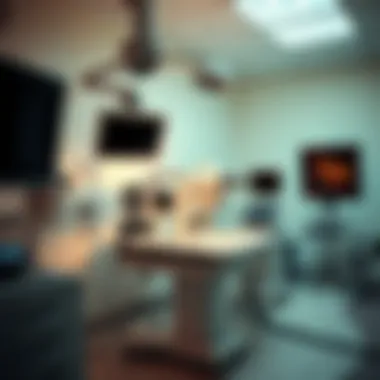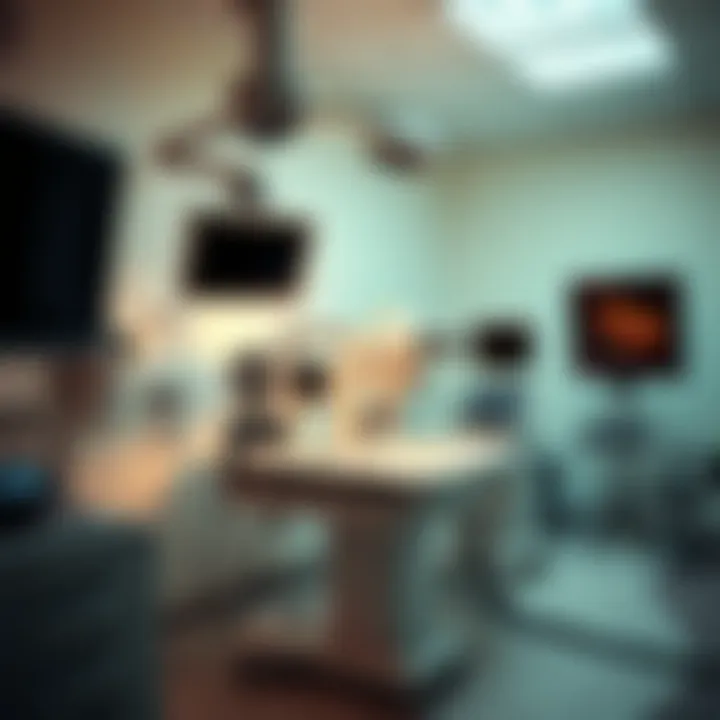Cost Analysis of Fiberoptic Endoscopic Evaluation of Swallowing


Intro
The landscape of healthcare is continuously evolving, and with it, the tools that practitioners rely on to provide quality care. One significant advancement has been the introduction of fiberoptic endoscopic evaluation of swallowing (FEES) equipment. While the clinical benefits of FEES are well-documented, the financial implications often remain in the shadows. This article meticulously investigates the cost factors associated with FEES technology, focusing on the equipment’s pricing, maintenance expenses, and the myriad influences that shape these costs. The evaluation will not just touch on the devices themselves but extend to their impact on healthcare facilities, serving as a guide for stakeholders considering the adoption of such technology.
Understanding these financial dynamics is pivotal for making informed decisions in clinical practice, and it can illuminate paths to greater efficiency and effectiveness in patient management. With the intricate balance between healthcare funding and resource allocation, diving into the cost implications of FEES equipment is not just worthwhile, it’s essential.
The segment on cost implications will be divided into a couple of main areas: the research overview and a detailed analysis of the findings. Through this structured approach, we hope to clarify the landscape of FEES equipment costs and their broader significance for the healthcare system.
Preamble to Fiberoptic Endoscopic Evaluation of Swallowing
Understanding and addressing swallowing disorders can be pivotal in improving patient outcomes. Fiberoptic Endoscopic Evaluation of Swallowing (FEES) serves as a innovative pathway for clinicians to assess these complex issues comprehensively. This article aims to explore the cost implications associated with FEES equipment, highlighting how this technology not only influences clinical practices but also impacts financial considerations for healthcare facilities.
The increasing demand for precision in examining swallowing difficulties has pushed FEES to the forefront of diagnostic procedures. This non-invasive approach allows clinicians to visualize swallowing in real-time, providing critical insights that go beyond traditional assessment techniques. Therefore, understanding the financial landscape surrounding FEES technology is essential for effective integration into practice.
Key benefits of utilizing FEES equipment include:
- Enhanced diagnostic accuracy through direct visualization of the swallowing process.
- Quick feedback allowing for immediate adjustment in treatment plans.
- Improved patient comfort compared to more invasive procedures like video fluoroscopy.
However, there are significant considerations regarding cost. Initial purchase costs for FEES equipment can be daunting. Additionally, operational expenses, including maintenance and consumables, can add to the financial burden. It is vital to evaluate these costs against the potential benefits, both in terms of patient outcomes and long-term savings.
"Investing in FEES technology not only requires a monetary commitment but foresight into its value proposition for patient care."
This section lays the groundwork for delving deeper into the specific aspects of FEES equipment, paving the way to a thorough examination of various types of devices.
Understanding FEES and Its Applications
Fiberoptic Endoscopic Evaluation of Swallowing is a technique that blends the art of medicine with cutting-edge technology. With the use of a flexible fiberoptic scope, clinicians can directly visualize the anatomy and function of the throat while a patient swallows.
The applications of FEES are vast, including:
- Evaluation of swallowing disorders in patients with neurological conditions, such as stroke or Parkinson's disease.
- Assessment of airway safety during swallowing, crucial for preventing aspiration pneumonia.
- Guidance for rehabilitation strategies by offering real-time feedback on swallowing mechanics.
FEES is particularly valuable in a setting such as a rehabilitation facility, where ongoing assessments can inform tailored modifications to therapy protocols. Its versatility allows it to be employed across various medical settings, enhancing its impact on patient care.
Historical Context of FEES Development
The journey of Fiberoptic Endoscopic Evaluation of Swallowing has roots in advancements in medical imaging and endoscopic technology. Initially developed to enhance the diagnosis of otolaryngological conditions, clinicians recognized its potential in assessing swallowing disorders in the early 1980s.
Key developments that marked its evolution include:
- Introduction of flexible fiberoptics, which enabled less invasive observations.
- Integration of video technology, allowing for recording and analyzing swallowing events in detail.
- Professional collaboration, as speech-language pathologists and otolaryngologists worked together to refine the technique and expand its usage.
FEES gained traction due to its immediate benefits in clinical practice. Its progress has been driven by both technological underpinnings and a growing appreciation for multidisciplinary approaches in patient management, shaping how swallowing disorders are viewed within the healthcare spectrum.
Types of FEES Equipment
When considering the fiberoptic endoscopic evaluation of swallowing, the equipment used plays a vital role in determining the success and effectiveness of the procedure. The types of FEES equipment involve various components that facilitate the endoscopic examination of swallowing, making this a critical point of focus for any healthcare facility looking to adopt this technology.
FEES primarily involves endoscopes and related hardware. Understanding the different types of equipment allows healthcare providers to make informed purchasing decisions that align with their clinical needs and budget constraints.
Endoscopes: Variations and Specifications
Endoscopes are the heart of FEES technology. These devices come in a variety of types and sizes, reflecting different medical requirements and patient needs. Some endoscopes, for example, are designed for pediatric use, while others are better suited for adults. The variations include parameters such as length, flexibility, and diameter, which are crucial for accessing the relevant anatomical regions without causing unnecessary discomfort to the patient.
Moreover, specifications such as the resolution of the image sensor and the angle of view can significantly influence the quality of the examination. A high-definition endoscope may provide clearer images of the pharynx and larynx, leading to better diagnoses.
Considerations settle not only in quality but also in the price point. A more expensive model may offer advanced features but may not always justify its cost in every clinical setting. Both initial investment and potential return on investment through improved patient outcomes should be balanced when making these decisions.
Light Sources and Image Processing Units


The effectiveness of a FEES examination is greatly enhanced by the quality of the light source and image processing units that accompany the endoscope. Bright, consistent illumination is essential to obtain clear and detailed images of the swallowing process. Equipment such as powerful LED light sources serves this purpose effectively, reducing shadows and enhancing contrast.
Moreover, image processing units convert raw images into a format suitable for analysis. The ability of these units to provide real-time processing can assist clinicians in making immediate assessments during the procedure. Without high-quality imaging and processing capabilities, even the best endoscope may fall short in value.
Equipment specifications can also include digital capture capabilities that permit long-term storage for reference and ongoing assessments. Given that these tools directly influence the overall accuracy of swallowing assessments, investing in superior light sources and image processing units can lead to more reliable outcomes.
"In the realm of medical technologies like FEES, a penny saved can often lead to a dollar lost in terms of diagnostic accuracy."
Ultimately, choosing the right types of FEES equipment requires a nuanced understanding of each component's role in the diagnostic process. It is not merely about acquiring instruments but also about ensuring that they intertwine to serve a common goal—improving patient care and diagnostic precision.
Cost Analysis of FEES Equipment
Understanding the financial considerations of fiberoptic endoscopic evaluation of swallowing (FEES) equipment is crucial for healthcare institutions. An in-depth cost analysis not only sheds light on the initial purchase aspects but also dives into the long-term operational expenses that institutions must plan for. It’s not just about buying the machine; it’s about sustaining it in a way that provides quality patient care without breaking the bank. Knowing these costs can lead to better financial planning and, ultimately, more informed decisions when it comes to investing in this sophisticated technology.
Initial Purchase Costs
The initial purchase costs of FEES equipment can vary widely depending on the specific technologies and brands being considered. Such variations arise not only from the equipment's complexity but also from the brand reputation and included features. For instance, a high-end model equipped with advanced imaging and real-time analysis capabilities might demand a steeper price tag compared to a more basic version.
Key Aspects of Initial Costs
- High-Quality Endoscopes: These can be costly. Some brands like Pentax or Olympus are known for their durability and superior quality. But does that justify the expense? For hospitals, that often depends on how frequently these devices will be used. For example, a facility in an urban area might find more substantial benefits in investing in high-end equipment due to the volume of patients requiring FEES evaluations.
- Package Deals: Some suppliers offer attraction prices when multiple pieces of equipment or comprehensive service agreements are bundled together. This could help in reducing costs considerably for facilities purchasing for the first time.
Considering these factors is pivotal. When weighing initial costs, facilities must evaluate their patient load and potential growth, which can shape the decision on whether to allocate funds toward premium equipment or more cost-effective solutions.
Long-term Operational Expenses
Once the equipment is in place, the ongoing operational expenses can have a significant impact on total cost of ownership. This encompasses maintenance costs and consumables, both of which require keen attention to avoid unexpected budget overruns.
Maintenance Costs
Maintenance for FEES equipment is not simply an optional expenditure; it’s a necessary component of ensuring the equipment performs reliably throughout its lifespan. Regular maintenance might involve calibration, software updates, or even component replacements to keep devices running at optimal levels.
- Key Characteristics: Consistent upkeep can prolong equipment durability and reliability, affecting patient outcomes and facility reputation.
- Budget Planning: Allocating a specific budget for these maintenance activities can prevent facilities from facing substantial financial burdens down the line when unexpected failures occur.
- Service Contracts: Some hospitals opt for service contracts that guarantee maintenance and support. While this may increase the yearly operational cost, it can also provide peace of mind and predictable budgeting.
Consumables
Consumables are often overlooked but can represent a considerable part of the long-term costs associated with FEES equipment. Items such as camera sheaths, disinfectants, and cables often require regular replenishment.
- Importance: The need for regular replacement of these consumables means that institutions must continually assess these costs against their operational budget.
- Cost-Benefit: Using high-quality consumables may be more expensive upfront but could lead to improved performance and patient care, justifying the investment from a quality standpoint.
- Alternative Options: Some facilities might explore third-party suppliers for consumables, which could offer significant savings over time but might compromise quality. This consideration deserves careful examination.
In sum, both maintenance and consumables play crucial roles in the ongoing success of FEES as a diagnostic tool. Each facility should evaluate their unique needs, patient volume, and budget constraints when analyzing these long-term operational costs.
Quote: "Understanding both initial and ongoing costs of FEES equipment helps facilities make informed decisions that enhance patient care while managing budgets effectively."
Investing in FEES technology is not without its challenges, but understanding costs can illuminate the path for strategic growth and enhanced patient diagnostics.
Factors Influencing Equipment Costs
In the landscape of medical technology, the factors determining the cost of equipment are as varied as the pieces themselves. When it comes to fiberoptic endoscopic evaluation of swallowing (FEES) equipment, understanding these factors is pivotal for healthcare practices looking to implement or upgrade their systems. Importantly, this analysis goes beyond the sticker price; it probes into a tapestry of elements that affect expenses across both initial investments and long-term budgeting.
Manufacturer Brand and Reputation
The choice of manufacturer carries substantial weight. Some names in the industry, like Pentax Medical and Olympus, have been around long enough to establish a formidable reputation for reliability and performance. This established rapport with healthcare professionals means that a significant amount of trust is placed in their products. When a provider selects equipment from a reputable brand, they are not only purchasing an endoscope but also tapping into years of innovation and customer service expertise.
This trust can sometimes translate to a premium price tag. Nonetheless, opting for a well-established brand often yields benefits such as better support services and improved warranty options. A healthcare facility must weigh the potential risks of purchasing from lesser-known manufacturers, which may offer equipment at a lower price but lack the same level of reliability or customer care.
Additionally, the reputation of a manufacturer might influence the resale value of the equipment. Should a facility ever wish to upgrade, equipment from a reputed brand will often fetch a higher price in the resale market, allowing for a more favorable return on investment.
Technological Advancements and Innovations


We live in a rapidly evolving technological landscape. In the context of FEES equipment, staying at the forefront of technology usually comes with a cost. Latest advancements often incorporate features like enhanced imaging capabilities, portability, and connectivity options that make these systems more versatile. For example, systems with high-definition imaging not only improve the evaluation but also reduce the likelihood of repeat exams.
Yet with newer technologies, there is often a price premium associated. Facilities must consider how crucial these features are in their specific applications. Investing in state-of-the-art technology might lead to higher upfront costs, but it could also streamline processes, improve patient outcomes, and potentially lead to cost savings in the long run.
When evaluating advancements, it’s essential to consider the learning curve associated with integrating new technology. Staff training might add additional expenses, which could vary significantly based on how intuitive the new systems are.
"Investing in fiberoptic endoscopic evaluation of swallowing equipment isn't just about the immediate costs; it encompasses understanding how optimal technology can influence long-term efficiency and patient care."
Market Trends in FEES Equipment Pricing
Understanding market trends in Fiberoptic Endoscopic Evaluation of Swallowing (FEES) equipment pricing is vital for healthcare professionals and administrators. Prices don't just reflect the initial purchase of the equipment; they also encompass long-term considerations, such as maintenance, upgrades, and the adoption of emerging technologies. Analyzing these trends provides insights that can assist institutions in making sound financial decisions while ensuring quality in patient care.
When considering the financial implications of FEES technology, it’s worthwhile for stakeholders to evaluate how market movements can affect budget allocation and resource management. With healthcare budgets continually under scrutiny, being aware of pricing shifts can lead to more strategic investments. In turn, these investments can influence the operational efficiency and effectiveness of swallowing assessments in clinical settings.
Comparative Analysis of Different Models
Within the scope of FEES equipment, not all devices are created equal. A comparative analysis of different models shows made visible distinctions in pricing, ranging from budget-friendly systems to high-end options boasting lauded features.
- Basic Models: Often serve small clinics or outpatient settings, featuring essential capabilities with minimal frills. These models provide a cost-effective solution for facilities with tight budgets.
- Mid-Range Options: Strike a balance between price and advanced features. Such systems may include better image processing units and ergonomic design, enhancing usability.
- Premium Systems: Aimed at larger healthcare institutions, these feature state-of-the-art technology, multi-functional capabilities, and comprehensive support. Consequently, they come with a heftier price tag but often justify the investment through improved outcomes.
Each model comes with unique advantages and trade-offs. Facilities are advised to assess their specific needs, the patient demographics they serve, and how each model aligns with their goals for patient care and operational efficiency.
Regional Variations in Pricing
Another critical layer to understand is the regional variations in pricing for FEES equipment. Geographical location can markedly influence costs due to factors such as local demand, competition, shipping and logistics expenses, and regional economic conditions.
- Urban vs. Rural: In urban settings, where competition among healthcare providers is fierce, prices might be lower as providers strive to attract patients. In contrast, rural areas may see higher costs driven by limited vendor access and higher logistics costs.
- International Comparisons: Looking at pricing trends across countries can yield interesting insights. For example, markets in North America generally have higher prices compared to Southeast Asian regions, where the same models might be sold at lower rates due to varying economic conditions.
The importance of recognizing these regional pricing differences cannot be overstated. Healthcare administrators need to conduct localized market research to ensure that prices align with their operational budgets while providing optimal patient care.
Funding and Financial Support for FEES Integration
When considering the implementation of fiberoptic endoscopic evaluation of swallowing (FEES) technology, financial constraints often take center stage. This segment explores the vital role that funding and financial support play in facilitating the adoption of FEES equipment within healthcare settings. With budgets tightening and the demand for comprehensive patient care increasing, understanding the avenues for financial assistance is crucial for providers aiming to integrate this essential technology.
"Investing in technology is more than a budget line; it’s a commitment to improved patient outcomes."
Insurance Reimbursement Challenges
One of the biggest hurdles facilities face when incorporating FEES equipment is the reimbursement landscape. Insurance companies often have intricate policies regarding coverage for diagnostic tests. In many instances, the requirements for reimbursement are not clearly defined, leaving healthcare providers in a quandary when it comes to certifying the necessity of FEES under certain conditions. This can lead to significant delays in diagnosis and treatment for patients, as well as financial strain on clinics that must front the costs for procedures not guaranteed to be reimbursed.
Several factors contribute to reimbursement challenges:
- Varying policy interpretations: Different insurers may view the utility of FEES differently, leading to inconsistent coverage decisions.
- Administrative burden: Managing claims can be labor-intensive, with providers needing to document not just the necessity of the assessment, but also justify its cost.
- Evolving guidelines: As clinical practices evolve, so do reimbursement policies, often leaving healthcare providers scrambling to keep up.
Without robust insurance support, the costs associated with purchasing and maintaining FEES equipment can become prohibitive, possibly deterring facilities from adopting this vital technology.
Grants and Institutional Support
Aside from insurance reimbursements, grants and institutional support play a crucial role in funding the necessary equipment. Various governmental agencies and private foundations recognize the significance of FEES in improving patient outcomes and, as such, offer grants to assist institutions in obtaining the technology needed.
Types of funding opportunities include:
- Government Grants: Many public health departments or federal programs provide competitive grants specifically aimed at enhancing diagnostic capabilities in healthcare settings.
- Research Funds: Academic institutions often offer financial resources for research projects that explore novel applications of FEES, which can, in turn, support the procurement of necessary equipment.
- Nonprofit Organizations: Groups dedicated to healthcare advancements may also provide funding or partnerships that could ease the financial burden of adopting FEES technology.
Securing such funding often requires a well-prepared proposal emphasizing not only the technical needs but also the anticipated impact on patient care.
Alternative Solutions to FEES
The exploration of alternative solutions to Fiberoptic Endoscopic Evaluation of Swallowing (FEES) is vital in understanding how modern healthcare can adapt to varied patient needs. While FEES presents a robust suite of benefits for clinicians assessing swallowing disorders, its costs can be a burden, particularly for smaller facilities or those in underfunded areas. This section delves into various methods and technologies that can either complement or serve as alternatives to FEES, assessing their effectiveness, cost efficiency, and potential integration into existing healthcare frameworks.


Comparative Effectiveness of FEES vs. Other Methods
When it comes to evaluating swallowing, traditional methods like videofluoroscopic swallow study (VFSS) often get pulled into the conversation. Both methods aim to assess and diagnose swallowing difficulties; however, they differ significantly in application and outcomes. While FEES is often hailed for its detailed visualization of function in a realistic setting, VFSS is a widely accepted paradigm that provides real-time imaging of swallowing mechanics in a controlled environment.
FEES emphasizes the assessment of secretion management and the direct impact of food textures, while VFSS brings clarity on functional movement. Each method has its strengths and weaknesses.
Key Considerations:
- Safety and patient comfort: FEES is generally a more comfortable option for patients, as it avoids exposure to radiation, unlike VFSS.
- Cost: Employing VFSS often requires more resources, including fluoroscopy equipment and radiologists.
- Accessibility: In certain locations, finding available radiology support for VFSS can be more challenging than accessing trained personnel for FEES.
Cost-Effective Technologies in Swallowing Assessments
Considering the financial strain healthcare providers face, exploring cost-effective technologies is essential. Several emerging modalities have garnered interest not merely for their price tags but for their capabilities that parallel those of FEES and VFSS.
- Ultrasound: This non-invasive technique uses sound waves to visualize structures during swallowing, providing real-time feedback without the risks associated with radiation. It can be a feasible option for facilities looking to cut costs while still offering comprehensive swallowing assessments.
- Smartphone Applications: Advancing technologies have given rise to smartphone applications that can offer preliminary assessments or track patient symptoms over time. While not a direct substitute for FEES, these applications help streamline workflows and can reduce costs by minimizing the need for extensive follow-ups.
- Telehealth Solutions: As telemedicine gains traction, virtual swallowing assessments can sometimes be implemented, allowing clinicians to evaluate patients remotely while reducing clinic overhead. This can significantly lower costs for both the facility and patients, although some limitations in physical examinations may arise.
In summary, the rise of cost-effective technologies in swallowing assessments is not simply a trend; it is a necessary evolution in response to financial pressures faced by healthcare providers.
By examining these alternative solutions, we gain not just an understanding of the potential for cost reduction but also an insight into how diverse approaches can cater to a spectrum of patient needs, ensuring that healthcare delivery remains robust and accessible.
Future Directions in FEES Technology and Costs
As we peer into the future of fiberoptic endoscopic evaluation of swallowing (FEES), it's clear that several dynamics will shape not just the efficiency of these technologies, but also their overall cost implications. Keeping in mind the rapid advancements in medical technology, understanding these future trajectories will be essential for healthcare facilities seeking to invest wisely. The interplay of innovative designs, market trends, and economic viability should be the cornerstone of future considerations in this realm.
Innovations Impacting Costs
The domain of FEES is witnessing a wave of innovations that are poised to redefine existing cost structures. One such breakthrough is the development of portable endoscopic systems. These compact units allow for easier transportation and setup, drastically reducing overhead associated with bulky, traditional machines. Not only do they enhance accessibility for smaller healthcare settings, but they also minimize costs linked to infrastructure—such as space and maintenance.
Additionally, improved imaging technology, like high-definition cameras and integrated AI analytics, is transforming the kind of data clinicians receive. While the initial outlay might seem steep, the long-term savings from enhanced diagnostic accuracy can outweigh these early costs, especially when it leads to better patient outcomes and fewer follow-up procedures.
Some other notable innovations include:
- Telehealth Integration: This enables remote consultations and examinations, potentially lowering the costs associated with patient transfers and facility overheads.
- Smart Sensors: They can alert medical staff to potential issues in real-time, thereby reducing the need for expensive in-hospital stays.
"With these advancements, costs related to misdiagnosis or inadequate evaluations could be significantly reduced, paving a smoother path toward more widespread FEES adoption."
Predictions for Market Evolution
Looking ahead, the market for FEES technology stands on the edge of notable evolution. As healthcare prioritizes patient-centered strategies, the demand for tailored solutions will likely rise. Equipment manufacturers will need to adapt to these changing expectations, leading to a more segmented market where bespoke solutions can command higher prices. In this scenario, while costs may shift, they will not necessarily increase universally.
Several trends can be anticipated:
- Consolidation of Manufacturers: As companies merge, the competition might lessen, affecting pricing but also potentially sparking innovation through pooled resources.
- Competition from Alternative Solutions: As alternative swallowing assessment technologies gain traction, FEES equipment could face price pressures leading to more competitive pricing strategies.
- Regulatory Changes: New regulations—whether they pertain to safety, efficacy, or insurance reimbursements—can lead to shifts in market access and costs.
Overall, while the precise trajectory remains uncertain, adaptations in the technological landscape will be integral to shaping cost outcomes in the FEES sector. Healthcare professionals and decision-makers should anticipate that these innovations will create a diverse array of financial implications, necessitating ongoing vigilance and strategic planning in how they integrate FEES into practice.
Finale: Evaluating Investment in FEES Technology
As we wrap up this extensive investigation into the costs associated with fiberoptic endoscopic evaluation of swallowing (FEES) technology, it's crucial to underline the multifaceted benefits and considerations regarding investment in this equipment. Healthcare decision-makers are increasingly tasked with navigating not only the technical merits of technologies such as FEES but also the financial impact these tools may impose on healthcare systems.
Summarizing Cost-Benefit Relationships
In assessing the cost-benefit ratio of FEES technology, several critical factors come into play. A deep dive into the preliminary costs, broadens one's understanding of how the initial investment can yield long-term savings. When healthcare facilities purchase FEES equipment, they are not just acquiring a diagnostic tool; they are investing in better patient outcomes.
Key Benefits:
- Improved Diagnosis: Timely and accurate diagnosis can lead to more effective treatment plans, saving costs associated with prolonged hospital stays or ineffective therapies.
- Patient Satisfaction: Minimally invasive procedures often lead to increased patient comfort and quicker turnaround times for treatment, translating to higher patient satisfaction rates – a critical factor in today’s healthcare landscape.
- Reimbursement Opportunities: With insurance reimbursement rates being influenced by patient outcomes, the proper use of FEES can positively affect financial returns for institutions.
However, it's also essential to recognize that the journey does not come without its pitfalls. Unexpected maintenance fees, staff training costs, and ongoing operational expenses can seep into the budget. To mitigate these risks, proactive planning is necessary, which often involves thorough research into supplier reliability, warranty coverage, and training provisions.
Final Thoughts on Future Adoption
Looking ahead, the landscape for FEES technology adoption seems promising, albeit littered with challenges. As technology continues to advance at a dizzying pace, future iterations of FEES equipment might become more accessible and user-friendly, lowering the barriers for healthcare facilities to integrate this essential technology into their practices.
Administering FEES not only shuffles a healthcare facility’s diagnostic capabilities to the forefront but also encourages a cultural shift toward precision medicine. For many clinics and hospitals, the integration of FEES is more than just an upgrade; it signifies a commitment to improved patient care and higher operational efficiencies.
In summary, as institutions weigh the pros and cons of investing in FEES technology, it's vital to look beyond the price tag. By acknowledging the potential for cost savings, enhanced quality of care, and increased patient satisfaction, stakeholders can make informed decisions that resonate with their overarching mission to provide superior healthcare. For those embarking on this journey, staying informed and prepared will be the key to harnessing the full power of FEES.















